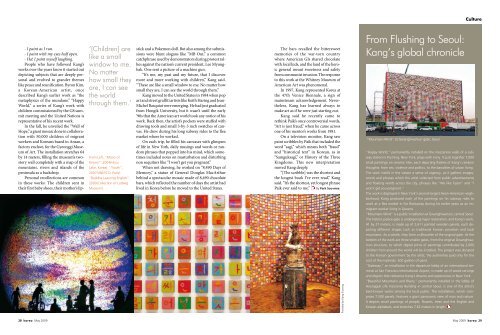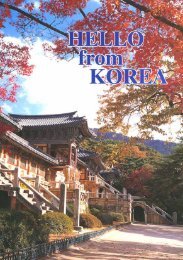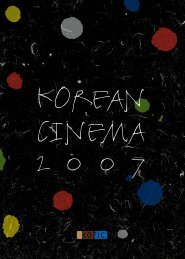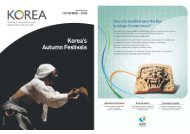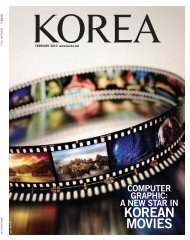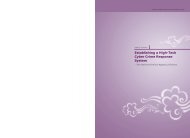2005-2162 The Buddha’s birthday illuminates Seoul
The Buddha's birthday illuminates Seoul - Korea.net
The Buddha's birthday illuminates Seoul - Korea.net
- No tags were found...
Create successful ePaper yourself
Turn your PDF publications into a flip-book with our unique Google optimized e-Paper software.
Culture<br />
‘[Children] are<br />
like a small<br />
window to me.<br />
No matter<br />
how small they<br />
are, I can see<br />
the world<br />
through them.’<br />
From Left, “Moon of<br />
Dream” ,2004(Hosu<br />
Lake, Korea). “Youth”,<br />
2007(UNESCO, Paris).<br />
“Buddha Learning English”,<br />
2000(Collection of Ludwig<br />
Museum).<br />
- I paint as I run.<br />
- I paint with my eyes half open.<br />
- Ha! I paint myself laughing.<br />
People who have followed Kang’s<br />
works over the years know it started out<br />
depicting subjects that are deeply personal<br />
and evolved to grander themes<br />
like peace and reunification. Byron Kim,<br />
a Korean-American artist, once<br />
described Kang’s earlier work as “the<br />
metaphysics of the mundane.” “Happy<br />
World,” a series of Kang’s work with<br />
children commissioned by the G8 summit<br />
meeting and the United Nations is<br />
representative of his recent work.<br />
In the fall, he unveiled the “Wall of<br />
Hope,” a giant mosaic done in collaboration<br />
with 50,000 children of migrant<br />
workers and Koreans based in Ansan, a<br />
factory enclave, for the Gyeonggi Museum<br />
of Art. <strong>The</strong> installation stretches 64<br />
by 14 meters, filling the museum’s twostory<br />
wall completely with a map of the<br />
mountains, rivers and islands of the<br />
peninsula as a backdrop.<br />
Personal recollections are common<br />
in these works: <strong>The</strong> children sent in<br />
their first baby shoes, their mother’s lipstick<br />
and a Pokemon doll. But also among the submissions<br />
were blunt slogans like “MB Out,” a common<br />
catchphrase used by demonstrators during protest rallies<br />
against the nation’s current president, Lee Myungbak.<br />
One sent a picture of a machine gun.<br />
“It’s me, my past and my future, that I discover<br />
more and more working with children,” Kang said.<br />
“<strong>The</strong>se are like a small window to me. No matter how<br />
small they are, I can see the world through them.”<br />
Kang moved to the United States in 1984 when pop<br />
art and street graffiti artists like Keith Haring and Jean-<br />
Michel Basquiat were emerging. He had just graduated<br />
from Hongik University, but it wasn’t until the early<br />
’90s that the American art world took any notice of his<br />
work. Back then, the artist’s pockets were stuffed with<br />
drawing tools and small 3-by-3 inch swatches of canvas.<br />
He drew during his long subway rides to the flea<br />
market where he worked.<br />
On each trip, he filled his canvases with glimpses<br />
of life in New York, daily musings and words or random<br />
phrases that popped into his mind, which sometimes<br />
included notes on masturbation and disturbing<br />
non sequiturs like “I won’t get you pregnant.”<br />
When not drawing, he worked on “8,490 Days of<br />
Memory,” a statue of General Douglas MacArthur<br />
behind a spectacular mosaic made of 8,490 chocolate<br />
bars, which reflected the number of days the artist had<br />
lived in Korea before he moved to the United States.<br />
<strong>The</strong> bars recalled the bittersweet<br />
memories of the war-torn country<br />
where American GIs shared chocolate<br />
with local kids, and the land of the heroic<br />
general meant sweetness and safety<br />
from communist invasion. <strong>The</strong> response<br />
to this work at the Whitney Museum of<br />
American Art was phenomenal.<br />
In 1997, Kang represented Korea at<br />
the 47th Venice Biennale, a sign of<br />
mainstream acknowledgement. Nevertheless,<br />
Kang has learned always to<br />
make art as if he were just starting out.<br />
Kang said he recently came to<br />
rethink Paik’s once controversial words,<br />
“Art is just fraud,” when he came across<br />
one of his mentor’s works from 1981.<br />
On a television monitor, Kang saw<br />
paint scribbles by Paik that included the<br />
word “sagi,” which means both “fraud”<br />
and “historical text” in Korean, as in<br />
“Samguksagi,” or History of the Three<br />
Kingdoms. This new interpretation<br />
moved Kang deeply.<br />
“[<strong>The</strong> scribble] was the shortest and<br />
the longest book I’ve ever read,” Kang<br />
said. “It’s the shortest, yet longest phrase<br />
Paik ever said to me.” By Park Soo-mee<br />
Provided by Kang Ik-joong<br />
From Flushing to <strong>Seoul</strong>:<br />
Kang’s global chronicle<br />
“Mountain-Wind” at Gwanghwamun gate, <strong>Seoul</strong><br />
“Happy World,” permanently installed on the mezzanine walls of a subway<br />
station in Flushing, New York, plays with irony. It puts together 7,000<br />
small paintings on ceramic tiles, each depicting flashes of Kang’s random<br />
thoughts: from sex, violence and politics, to the banalities of urban living.<br />
<strong>The</strong> work instills in the viewer a sense of urgency, as it gathers images,<br />
words and phrases which the artist collected from public advertisements<br />
and floating words across the city, phrases like “We like Tyson” and “I<br />
won’t get you pregnant.”<br />
<strong>The</strong> work is displayed in New York’s second-largest Asian-American neighborhood;<br />
Kang produced each of the paintings on his subway rides to<br />
work at a flea market in Far Rockaway during his earlier years as an immigrant<br />
worker living in Queens.<br />
“Mountain-Wind” is a public installation at Gwanghwamun, central <strong>Seoul</strong>.<br />
<strong>The</strong> historic palace gate is undergoing major restoration, and Kang’s work,<br />
41 by 27 meters, is made up of 2,611 painted wooden panels, each depicting<br />
different shapes such as traditional Korean porcelain and local<br />
mountains. As a whole, they form a silhouette of the original gate. At the<br />
bottom of the work are three smaller gates, from the original Gwanghwamun<br />
structure, to which digital prints of paintings contributed by 2,000<br />
children from around the world will be installed. <strong>The</strong> project was donated<br />
to the Korean government by the artist; the authorities paid only for the<br />
cost of the materials: 500 gallons of paint.<br />
“Gateway,” an installation in the departure lobby of an international terminal<br />
at San Francisco International Airport, is made up of wood carvings<br />
and objects that reference Kang’s dreams and experiences in New York.<br />
“Beautiful Mountains and Rivers,” permanently installed in the lobby of<br />
Heungguk Life Insurance Building in central <strong>Seoul</strong>, is one of the artist’s<br />
best-known works among the local public. <strong>The</strong> installation, which comprises<br />
7,500 panels, features a giant panoramic view of man and nature.<br />
It depicts small paintings of people, flowers, trees and the English and<br />
Korean alphabets, and stretches 7.62 meters in length.<br />
[joongAng Ilbo]<br />
28 korea May 2009 May 2009 korea 29


